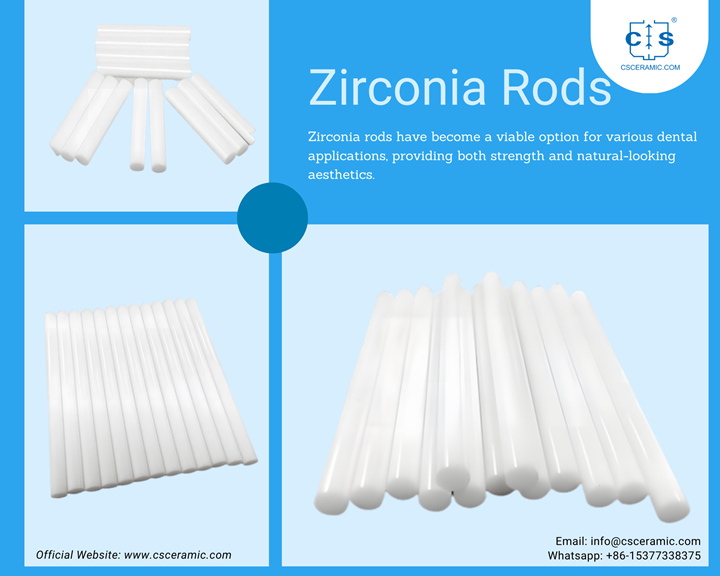Monolithic vs. Layered Zirconia Rods: Which is Better for Dental Applications?
Content Table
I. Introduction
- Brief explanation of zirconia rods
- Importance of zirconia rods in dental applications
IV. Comparison between Monolithic and Layered Zirconia Rods
A. Strength and durability
B. Aesthetics and natural appearance
C. Color matching capabilities
D. Risk of chipping or fracturing
E. Ease of fabrication and customization
II. Monolithic Zirconia Rods
A. Definition and characteristics
B. Advantages
1. Strength and durability
2. Aesthetics and natural appearance
3. Reduced risk of chipping or fracturing
C. Disadvantages
1. Limited shade options
2. Difficulty in achieving precise color matching
V. Conclusion
- Summary of key points
- Importance of considering individual patient cases
III. Layered Zirconia Rods
A. Definition and characteristics
B. Advantages
1. Enhanced esthetics and customization
2. Improved color matching capabilities
3. Ability to replicate natural tooth translucency
C. Disadvantages
1. Potential for chipping or delamination
2. Slightly lower strength compared to monolithic zirconia
VI. FAQs
1. Are zirconia rods suitable for all dental applications?
2. How long do zirconia rods typically last?
3. Can zirconia rods be repaired if damaged?
4. What factors should be considered when choosing zirconia rods?
5. Is one type of zirconia rod better than the other overall?
Introduction
The field of dentistry has seen significant advancements in materials used for dental restorations. Zirconia, a durable and aesthetically pleasing ceramic material, has gained popularity in recent years.
Zirconia rods, in particular, have become a viable option for various dental applications, providing both strength and natural-looking aesthetics. When it comes to zirconia rods, there are two main types: monolithic and layered. In this article, we will delve into the characteristics, advantages, and disadvantages of both monolithic and layered zirconia rods.
By understanding the differences between these two options, dental professionals can make informed decisions in selecting the most suitable rod for their patients.
Monolithic Zirconia Rods
Monolithic zirconia rods are composed of a single solid piece of zirconia. These rods are known for their exceptional strength and durability, making them an excellent choice for dental restorations. One of the primary advantages of monolithic zirconia is its resistance to chipping or fracturing, ensuring long-lasting restorations for patients. Additionally, monolithic zirconia rods offer a natural appearance, closely resembling the shade and translucency of natural teeth.
Despite their numerous advantages, monolithic zirconia rods have a few limitations. One of these limitations is the limited shade options available. Compared to layered zirconia rods, achieving precise color matching with monolithic zirconia can be more challenging. However, advancements in zirconia technology continue to address this limitation, with the development of more shades and translucencies.
Layered Zirconia Rods
Layered zirconia rods, also known as veneered or aesthetic zirconia rods, consist of a zirconia core covered with layers of ceramic material. This layered approach allows for enhanced customization and improved esthetics. Dental technicians can apply various shades and layers of ceramic to achieve lifelike translucency, making layered zirconia rods an excellent choice for highly esthetic restorations.
The ability to achieve precise color matching is one of the primary advantages of layered zirconia rods. Dentists and dental technicians can closely replicate the natural shades and translucencies of the patient's existing teeth, resulting in a seamless and natural-looking smile. Layered zirconia rods offer superior esthetics, making them a popular choice for anterior restorations.
However, layered zirconia rods are not without their limitations. Due to the additional layers of ceramic, there is a slight increase in the risk of chipping or delamination compared to monolithic zirconia. Additionally, while layered zirconia rods are still highly durable, they may not possess the same level of strength as their monolithic counterparts.

Comparison between Monolithic and Layered Zirconia Rods
When choosing between monolithic and layered zirconia rods, several factors need to be considered. In terms of strength and durability, monolithic zirconia rods have the edge, providing excellent resistance against chipping or fracturing. However, layered zirconia rods offer superior esthetics and color matching capabilities, making them ideal for anterior restorations where natural appearance is paramount.
While monolithic zirconia rods have a limited shade range, advancements in zirconia technology are continually expanding the available options. On the other hand, layered zirconia rods can replicate the precise shades and translucencies of natural teeth, offering a broader range of esthetic possibilities.
Another factor to consider is the risk of chipping or delamination. Monolithic zirconia rods have a lower risk in this regard, whereas layered zirconia rods may be slightly more susceptible. However, with proper fabrication and care, the risk can be minimized.
Overall, the selection between monolithic and layered zirconia rods depends on the specific needs of the patient. It is crucial for dentists and dental technicians to collaborate and assess each patient's case individually, taking into account factors such as the location of the restoration, esthetic requirements, and patient preferences.
Conclusion
Zirconia rods have revolutionized dental restorations, providing strength, durability, and natural aesthetics. When it comes to choosing between monolithic and layered zirconia rods, there is no definitive answer as to which is better. Each type has its own set of advantages and limitations. The decision should be based on the individual patient's needs and the desired outcome of the restoration. By carefully considering these factors and collaborating effectively, dental professionals can ensure optimal results for their patients.
FAQs
1. Are zirconia rods suitable for all dental applications?
Zirconia rods are versatile and can be used in various dental applications, including crowns, bridges, and implant restorations. However, the suitability may depend on specific cases, and dentists should evaluate each patient individually.
2. How long do zirconia rods typically last?
Zirconia rods are known for their durability and longevity. With proper care and maintenance, they can last for many years, often exceeding a decade.
3. Can zirconia rods be repaired if damaged?
In the event of damage or wear, zirconia rods can be repaired or polished by a dental professional. However, the extent of repair depends on the nature and severity of the damage.
4. What factors should be considered when choosing zirconia rods?
When selecting zirconia rods, factors such as strength, esthetics, color matching capabilities, and the specific needs of the patient should be taken into account. Collaboration between dentists and dental technicians is crucial in making informed decisions.
5. Is one type of zirconia rod better than the other overall?
The choice between monolithic and layered zirconia rods depends on the specific requirements of each case. Both types have their advantages and limitations, and the decision should be based on individual patient needs and desired outcomes.
Thank you for reading. We invite you to visit CSCERAMIC for more information if you would like to learn more about industrial ceramic material and the advanced range of ceramic products we offer.




 info@csceramic.com
info@csceramic.com







 +86 18273288522
+86 18273288522